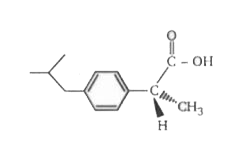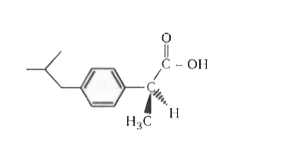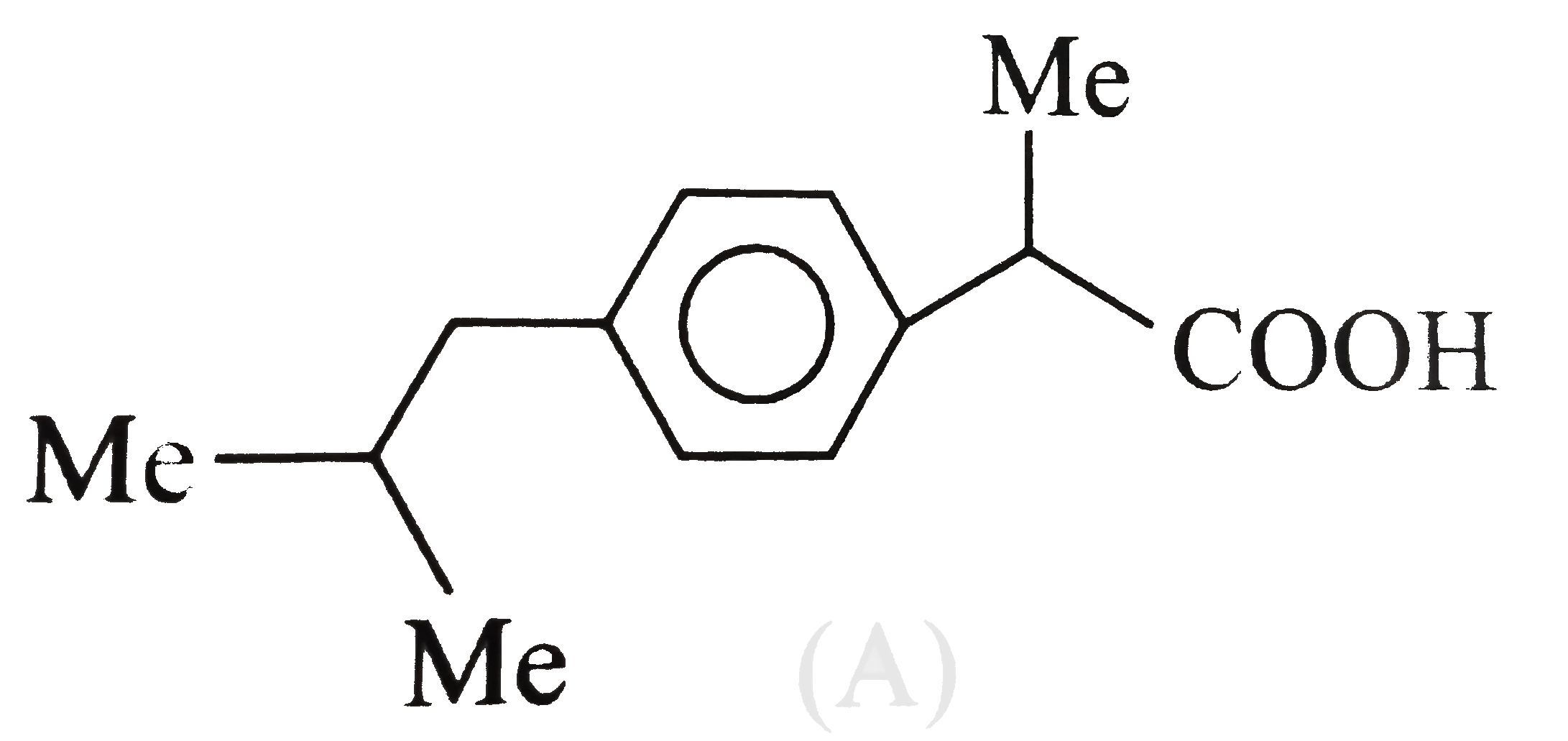The analgesic drug ibuprofen (A) is chiral and exists in (+) and (-) froms. One enantiomer is physiologically active, while the other is inactive. The other is inactive. The structure of ibuprofen is given below.

The number of π - bonds in (A) is :
2
3
4
5
The correct Answer is:C
(33 σ- bonds and 4π- bonds)

Topper's Solved these Questions
- CLASSIFICATION AND NOMENCLATURE OF ORGANIC COMPOUNDSBOOK - CENGAGE CHEMISTRY ENGLISHCHAPTER - CLASSIFICATION AND NOMENCLATURE OF ORGANIC COMPOUNDSEXERCISE - Multiple corrcct Answers Types
11 Videos
- CLASSIFICATION AND NOMENCLATURE OF ORGANIC COMPOUNDSBOOK - CENGAGE CHEMISTRY ENGLISHCHAPTER - CLASSIFICATION AND NOMENCLATURE OF ORGANIC COMPOUNDSEXERCISE - Single correct Answer Type
44 Videos
- CLASSIFICATION AND NOMENCLATURE OF ORGANIC COMPOUNDSBOOK - CENGAGE CHEMISTRY ENGLISHCHAPTER - CLASSIFICATION AND NOMENCLATURE OF ORGANIC COMPOUNDSEXERCISE - Concept Application Type
7 Videos
- CHEMICAL EQUILIBRIUMBOOK - CENGAGE CHEMISTRY ENGLISHCHAPTER - CHEMICAL EQUILIBRIUMEXERCISE - Subjective type
1 Videos
- GENERAL ORGANIC CHEMISTRYBOOK - CENGAGE CHEMISTRY ENGLISHCHAPTER - GENERAL ORGANIC CHEMISTRYEXERCISE - Analytical and Descriptive
1 Videos
Similar Questions
The analgesic drug ibuprofen (A) is chiral and exists in (+) and (-) froms. One enantiomer is physiologically active, while the other is inactive. The other is inactive. The structure of ibuprofen is given below.

The number of σ-bonds in (A) is:
View SolutionThe analgesic drug ibuprofen (A) is chiral and exists in (+) and (-) froms. One enantiomer is physiologically active, while the other is inactive. The other is inactive. The structure of ibuprofen is given below.

The IUPAC name of (A) is:
View Solution
Knowledge Check
The S- enantiomer of ibuprofen is responsible for its pain-relieving properties. Which one of the following structures shown below is (S)-ibuprofen ?
A B
B C
C D
D
The chemical formula of deoxyribonucleic acid
(DNA) is now well established. The molecule is a
very long chain, the backbone of which consists of a
regular alternation of sugar and phosphate groups.
5 To each sugar is attached a nitrogenous base, which
can be of four different types. Two of the possible
bases—adenine and guanine—are purines, and the
other two—thymine and cytosine—are pyrimidines.
So far as is known, the sequence of bases along the
10 chain is irregular. The monomer unit, consisting of
phosphate, sugar and base, is known as a nucleotide.
The first feature of our structure which is of
biological interest is that it consists not of one chain,
but of two. These two chains are both coiled around
15 a common fiber axis. It has often been assumed that
since there was only one chain in the chemical
formula there would only be one in the structural
unit. However, the density, taken with the X-ray
evidence, suggests very strongly that there are two.
20. The other biologically important feature is the
manner in which the two chains are held together.
This is done by hydrogen bonds between the bases.
The bases are joined together in pairs, a single base
from one chain being hydrogen-bonded to a single
25 base from the other. The important point is that only
certain pairs of bases will fit into the structure.
One member of a pair must be a purine and the other
a pyrimidine in order to bridge between the two
chains. If a pair consisted of two purines, for
30 example, there would not be room for it.
We believe that the bases will be present almost
entirely in their most probable forms. If this is true,
the conditions for forming hydrogen bonds are more
restrictive, and the only pairs of bases possible are:
35 adenine with thymine, and guanine with cytosine.
Adenine, for example, can occur on either chain, but
when it does, its partner on the other chain must
always be thymine.
The phosphate-sugar backbone of our model is
40 completely regular, but any sequence of the pairs of
bases can fit into the structure. It follows that in a
long molecule many different permutations are
possible, and it therefore seems likely that the precise
sequence of bases is the code which carries the
45 genetical information. If the actual order of the bases
on one of the pair of chains were given, one could
write down the exact order of the bases on the other
one, because of the specific pairing. Thus one chain
is, as it were, the complement of the other, and it is
50 this feature which suggests how the deoxyribonucleic
acid molecule might duplicate itself.
The table shows, for various organisms, the percentage of
each of the four types of nitrogenous bases in that
organism’s DNA.

Adapted from Manju Bansal, “DNA Structure: Revisiting the
Watson-Crick Double Helix.” ©2003 by Current Science Association,
Bangalore
25. The authors’ main purpose of including the information about X-ray evidence and density is toAestablish that DNA is the molecule that carries the genetic information.Bpresent an alternate hypothesis about the composition of a nucleotide.Cprovide support for the authors’ claim about the number of chains in a molecule of DNA.Dconfirm the relationship between the density of DNA and the known chemical formula of DNA.
The analgesic drug ibuprofen (A) is chiral and exists in (+) and (-) froms. One enantiomer is physiologically active, while the other is inactive. The other is inactive. The structure of ibuprofen is given below.

The principal functional group in (A) is:
View SolutionAspirin is widely used as an analgesic drug. It is optically inactive. The structure of aspirin is:

The number of π - bonds in (A) is:
View SolutionAspirin is widely used as an analgesic drug. It is optically inactive. The structure of aspirin is:

The number is σ - bonds in (A) is:
View SolutionThe total number of optically inactive products obtained from the complete ozonolysis of the compound given below here is

View SolutionBroadly speaking there are four types of stereisomers namely conformational isomers geometrical isomers, enantiomers and diastereomers.Although conformational isomers , have same configuration geometrical isomers have different atoms attached to each of the doubly bonded carbon atom, and enantiomers are due to chirality in the molecule Enantiomers are also known as optical isomers and diastereomers are those stereoisomers which are not enantiomers.In simple compound, number of stereoisomers.In chiral molecule is given by the reaction 2n, where n is the number of dissimilar chiral carbon.
Observe the following structures and answer the questions given below :

How many stereoisomers are possible in pent-3-en-2-ol, CH3CH=CHCHOHCH3
View SolutionCompound which rotates the plane polarised light is known as optically active compound . On the basis of direction of rotation two forms of an optically active compounds are termed as dextro and laevo rotatory . The two are termed as enantiomers . If we have a 1 : 1 mixture of d and l isomers of a given chiral compound , optical rotation of such mixture is zero Such a mixture is optically inactive and is called a recemic modification.
The net specific rotation of any mixture of the d and isomers of a given chiral compound is equal to the weighted average of the rotations due to both the isomers Mathematically if can be expressed as :
[α]≠t=fd[αd]+f1[αl]
Where fa and fl are fractions of d and l isomers respectively and [αd],[αl] are their specific rotations
The pure d isomer of certain chiral compound has
[α]25d=+55∘.A non racemic mixture of this compound has a net [α]25d=−11∘. What is the fractions of this isomer in mixture ?
View Solution
